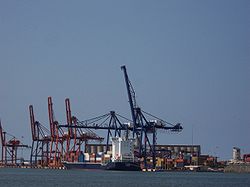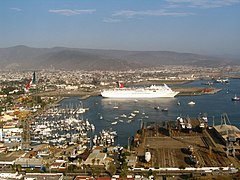Transportation in Mexico

As the third largest and second most populous country in Latin America, Mexico has developed an extensive transportation network to meet the needs of its economy and growing population. Regulated by the Secretariat of Communications and Transportation (Secretaría de Comunicaciones y Transportes, SCT), a federal executive cabinet branch, Mexico's transportation system includes modern highways, a well-connected bus network, railways primarily used for freight, and a network of domestic and international airports.
These infrastructures facilitate trade, tourism, and domestic travel, supporting Mexico's economic activities and connecting its diverse regions efficiently. However, challenges such as traffic congestion and safety concerns persist, particularly in urban centers, highlighting ongoing efforts to improve and expand the country's transportation capabilities.
Roadways
[edit]


| Highway network | |
|---|---|

| |
| M57-D Expressway joining Saltillo and Mexico City | |
| Total extension | 332,031 km |
| Paved highways | 116,802 km |
| Multi-lane expressways | 10,474 km |
The roadway network in Mexico is extensive and covers all areas of the country.[1] The roadway network in Mexico has an extent of 366,095 km (227,481 mi),[2] of which 116,802 km (72,577 mi) are paved,[3] making it the largest paved-roadway network in Latin America.[4] Of these, 10,474 km (6,508 mi) are multi-lane expressways: 9,544 km (5,930 mi) are four-lane highways and the rest have six or more lanes.[3]
The highway network in Mexico is classified by number of lanes and type of access. The great majority of the network is composed of undivided or divided two-lane highways, with or without shoulders, and are known simply as carreteras. Four or more-lane freeways or expressways, with restricted or unrestricted access, are known as autopistas. Speed limits on two-lane highways can vary depending on terrain conditions. The speed limit on multi-lane freeways or expressways is on average 110 km/h (70 mph) for automobiles and 95 km/h (60 mph) for buses and trucks.
The expressways are for the most part toll roads or autopistas de cuota. Non-toll roads are referred to as carreteras libres (free-roads). Most toll expressways have emergency telephone booths, water wells, and emergency braking ramps at short intervals. The toll usually includes a "travelers' insurance" (seguro del viajero) for any accident occurring within the freeway.[5][6] The toll expressways are on average among the most expensive in the world according to a comparative study realized in 2004 by the Chamber of Deputies.[7] The most traveled freeways are those that link the three most populous cities in Mexico— Mexico City, Guadalajara, and Monterrey in the form of a triangle.[1]


No federal freeway or expressway crosses a city; toll expressways are either turned into toll bypasses (libramientos), often used as toll or free ring roads (periféricos), or are turned into major arterial roads even if they function as freeways with restricted access.
Mexican highways are assigned a one to three-digit number. North-south highways are assigned odd numbers whereas east-west highways are assigned even numbers. Toll expressways usually run parallel to a free road and so are assigned the same number with the letter "D" added. (For example, the undivided two-lane highway connecting Mexico City and Puebla is MX 150, and the six-lane toll expressway is MX 150D).
Mexico has had difficulty in building an integrated highway network because of the country's orography and landscape characteristics[8]—most of the country is crossed by high-altitude ranges of mountains. Over the last two decades, Mexico has made impressive investments in order to improve its road infrastructure and connect main cities and towns across the country.[9] In spite of its extension and recent development, the roadway network in Mexico is still inadequate to meet the current needs of the population and except for the toll roads,[10] and they are often inadequately maintained.[1]
An additional problem is that in the center of the country the roads run into Metropolitan Mexico City from regional centers, but there are few roads that run peripherically to connect the other regional centers without running through the congestion around the capital. The federal government, in partnership with the government of Mexico State and the Federal District, has tried to alleviate that problem by constructing a tolled Mexico City bypass highway, "Arco Norte," which was partially opened in 2009.[11]
Railroads
[edit]

Mexico privatized its freight rail service with the dissolution of the former Ferrocarriles Nacionales de México freight service in 1998, leading to significant improvements and modernization in the sector. Today, the country boasts a robust rail network primarily operated by companies like Ferromex and Kansas City Southern de México, which facilitate the transport of various goods across the nation. In addition to freight, Mexico also supports urban rail infrastructure, including the Mexico City Metro and the Monterrey Metro, along with light rail systems such as the Xochimilco Light Rail in Mexico City and the Guadalajara Light Rail System. Looking towards the future, the Secretariat of Communications and Transport of Mexico has proposed ambitious projects like a high-speed rail link from Mexico City to Guadalajara, with stops in Querétaro, Guanajuato, León, and Irapuato, allowing passengers to travel at speeds of 300 km/h and reducing travel time between these cities significantly compared to road transport.[12][13] With connected line running from the port city of Manzanillo to Aguascalientes. These initiatives highlight Mexico's ongoing efforts to enhance both its freight and passenger rail services to meet the growing demands of its economy and population.
The Tren Maya, also referred to as the Maya Train, represents a groundbreaking railway initiative spearheaded by President Andrés Manuel López Obrador Obrador in Mexico. Stretching across 1,500 kilometers, it intricately links prominent tourist hotspots such as Cancún, Tulum, and Palenque, with a profound objective to catalyze regional advancement and tourism. Notably crafted with sustainability as a cornerstone, the project is committed to honoring indigenous rights and preserving cultural legacies. With its ambitious scope, the Tren Maya aims to revolutionize connectivity, foster employment opportunities, and propel socio-economic development throughout the Yucatán Peninsula and southern Mexico.
Airports and air travel
[edit]| Airport and air traffic | |
|---|---|

| |
| Aeroméxico's Boeing 757-200 at T-1 in Mexico City International Airport | |
| 1,834 (2007) | |
| Paved runways | 231 |
| Largest airport | Mexico City International Airport (26 million p/year) |

Mexico has an extensive network of modern airports all throughout the territory;[14] flying domestically is considered efficient and safe.[14] Airport infrastructure in Mexico is the most advanced in Latin America:[15] all the cities with more than 500,000 inhabitants have an airport. There are 1834 airports in Mexico, the third-largest number of airports by country in the world.[16] The seven largest airports—which absorb 90% of air travel—are (in order of air traffic): Mexico City International Airport, Cancún International Airport, Guadalajara International Airport, Monterrey International Airport, Tijuana International Airport, Acapulco International Airport, and Licenciado Gustavo Díaz Ordaz International Airport (Puerto Vallarta).[15] All airports are privately owned, with the exception of Mexico City International Airport. This airport remains the largest in Latin America and the 44th largest in the world[17] transporting close to 26 million passengers a year.[18]
There are more than 70 domestic airline companies in Mexico.[1] The major player in the industry is Aeroméxico, owned by Grupo Financiero Banamex. Mexicana de Aviación, the oldest airline in Mexico, was the second player of the industry until it ceased operations in August 2010. Other small airlines include Aeroméxico Connect (Aeromexico regional subsidiary), Click Mexicana (Mexicana's low cost subsidiary), Aviacsa, Volaris, Interjet, TAR Aerolineas, Aeromar, VivaAerobus, Magnicharters and Republicair.
The governments of the United States and Mexico recently approved an agreement of "open skies", which allows low-cost carriers to operate point-to-point (direct) routes between American and Mexican cities.[14] This will decentralize air traffic in North America by bypassing major hubs and connecting smaller cities directly.
Seaports
[edit]

Mexico has a total of 76 seaports and 10 river ports.[19] The country's maritime infrastructure supports a diverse range of economic activities and trade. Among these ports, four major seaports stand out for concentrating approximately 60% of Mexico's merchandise traffic. These key ports include Altamira and Veracruz on the Gulf of Mexico, and Manzanillo and Lázaro Cárdenas on the Pacific Ocean. Following closely in terms of traffic are ports like Acapulco, Puerto Vallarta, Guaymas, Tampico, Topolobampo, Mazatlán, and Tuxpan. Each of these ports plays a vital role in facilitating the import and export of goods, supporting industrial activities, and enhancing Mexico's connectivity with global markets.
The Port of Acapulco, known for its historical and touristic importance, handles minerals and agricultural products alongside its tourist traffic. Puerto Vallarta's port supports tourism and fishing industries while managing cargo operations. Guaymas Port, strategically positioned on the Sea of Cortez, specializes in minerals, agricultural exports, and manufacturing products. Topolobampo Port in Sinaloa primarily exports grains and produce. Mazatlán Port on the Pacific coast manages a mix of agricultural products and manufactured goods. Tuxpan Port on the Gulf of Mexico is emerging as a key hub for container shipping and automotive exports. Together, these ports facilitate the movement of goods, support local industries, and connect Mexico to global markets, reflecting its pivotal role in international trade and commerce.
See also
[edit]References
[edit]- ^ a b c d Mexico Infrastructure, power and Communications. National Economies Encyclopedia. Retrieved 13 January 2007
- ^ CIA - The World Factbook. CIA World Factbook. Retrieved on 20 December 2010
- ^ a b Infraestructura Carretera Archived 16 July 2007 at the Wayback Machine. Secretaría de Comunicaciones y Transportes. México. Retrieved 13 January 2007
- ^ With data from The World Factbook
- ^ Seguro de Viajero en Carreteras Federales[dead link]. November 2004. Retrieved 13 January 2007
- ^ Toll Roads and Driving in Mexico. Mexperience.com. Retrieved 13 January 2007.
- ^ México, aún con las autopistas más caras. El Siglo de Torreón. 8 May 2006. Accessed 13 January 2008.
- ^ Transportations and Telecommunications. Mexico. Encyclopædia Britannica. Retrieved 14 January 2008
- ^ Guide to Toll Roads in Mexico. Toll Roads and Driving in Mexico. Mexperience.com. Retrieved 13 January 2007.
- ^ The Development of Mexico's Road Network. Getting Around in Mexico. Mexperience. Retrieved 13 January 2007.
- ^ Arco Norte web site Archived 22 August 2010 at the Wayback Machine Retrieved 25 August 2010
- ^ Hawley, Chris (6 January 2006). "Mexico reviving travel by train". Arizona Republic. Phoenix.
- ^ "Systra : Project for a Mexico City - Guadalajara High Speed Line. Rail transport engineering, public transport engineering". Archived from the original on 1 May 2011. Retrieved 30 October 2010.
- ^ a b c Domestic Flights in Mexico. Mexperience. Accessed 19 January 2008
- ^ a b Infrastructuras. Información de México. Ministerio de Industria, Turismo y Comercio de España.
- ^ Ranking on the number of airports per country. CIA Factbook
- ^ Acerca del AICM. Posicionamiento del Aeropuerto Internacional de la Ciudad de México (AICM) con los 50 aeropuertos más importantes del mundo Archived 16 July 2012 at the Wayback Machine
- ^ Acerca del AICM, Pasajeros Archived 31 May 2008 at the Wayback Machine
- ^ Transporte Marítimo. México Archived 27 May 2008 at the Wayback Machine. Centro de Información y Documentación Empresarial sobre Iberoamérica
External links
[edit]- (in Spanish) Información de transporte en Mexico
- (in Spanish) Secretaria de Comunicaciones y Transportes portal
- Information on Mexico Infrastructure Projects and related investments
- MEXLIST general repository of Mexican railway information
- Mexican Bus Company Websites (defuncional)
- Annual conference in on Mexico Infrastructure Projects including energy, transportation, logistics and water
- Directory of Mexican Bus Company categorized by City with updated timetables
